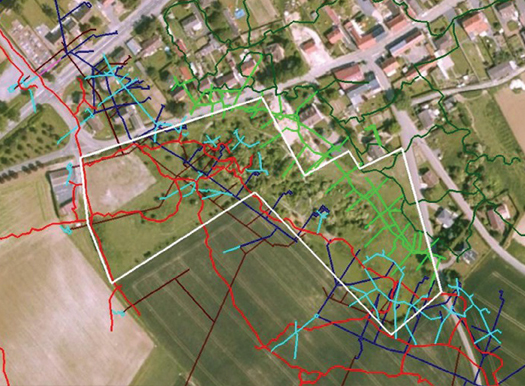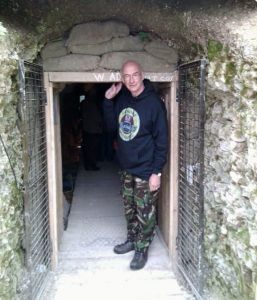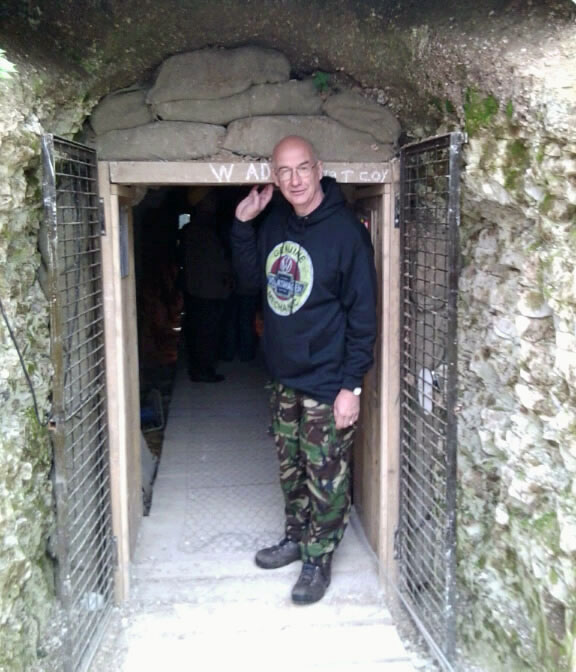The village of La Boisselle sits on the front lines that ran across the Picardy countryside prior to the 1916 Battle of the Somme. When the British took over the sector from the French in the summer of 1915 the ground had already been heavily fought over.
By July 1916 the ruined village was fortified and in German hands, enclosed by a maze of trenches and divided from the British lines by a belt of mine craters, evidence of a separate war that took place below the ground.

Today, there are still visible reminders of the fighting.
Many Leger travellers will have visited the huge Lochnagar Crater, a few hundred metres south of the village, the result of 60,000 lbs of explosive blown at 07:28 hrs on the morning of 1 July 1916. The sharper eyed amongst you will have spotted the chalky outlines of the former trenches snaking their way across the now peaceful fields.
As your coach made its way towards the crater, many will have had their attention drawn to an area of rough ground on the southeastern edge of La Boisselle. This 2- hectare piece of privately owned land is known as the Glory Hole. Still scarred by mine craters, it is now the subject of a long term, in-depth archaeological, historical, technological and genealogical study by the La Boisselle Study Group.
As a result of a personal plea for help by the French landowners, historian Peter Barton brought together an international group of specialists to form the La Boisselle Study Group.
I became one of the founder members, and in 2011 between Leger battlefield tours, I worked with the landowners and project members clearing many years of tree and vegetation growth.
The Group has its own team of dedicated archaeologists led by Anthony Byledbal of the University of Artois.
The ground clearance exposed more mine craters, shell holes and vestiges of trenches. Stormy weather had also caused a small collapse on the land which revealed a tunnel (X incline) leading to a chamber off which a further incline (W Adit) led up towards the surface.
In the chamber was a 50-foot deep shaft, that connects the 30-foot level with the main fighting tunnels at a depth of 80 feet. The entire Glory Hole sector has an estimated 5 miles of tunnels beneath it.

The allied tunnels descend to 100 feet and consist of three main levels. Facing them was a slightly deeper German system, together they formed a secret underground battlefield in which men fought until the beginning of the Battle of the Somme in 1916.
Archival and genealogical research in the UK and France has shown that there are still at least 38 French and British soldiers buried in the deep tunnels, victims of the underground war.
Research continues in Munich and Stuttgart to reveal the German side of the story and will lead to the identification and location of missing German miners. These men were lost beyond recovery, entombed in the galleries by underground explosions. It is a purpose of the project to ensure that they remain undisturbed in perpetuity and that their resting places are permanently marked on the surface above.
With a contract and archaeological permission in place, and with continuing archival research in the UK and Germany, October 2011 saw the first week of excavations at the site.
The team focused on the entrance to X incline, a small section of Quémart Trench, and locating the head of W Adit. It was a week that eventually saw the head of W Adit open for the first time in over 90 years.
The entrance and tunnel was made safe, the site interpreted and signed, and an Open Day held for the local people. Many hundreds visited the site, astonished to see what lies beneath their feet.
With the support of the landowners, from the very outset of the project the LBSG has had public access at the core of its philosophy. If we are working, the site is always open. The project’s profile is therefore already of the highest order, and our work continues to draw intense media interest. You may have seen coverage on BBC News and in newspapers and magazines.
In addition Peter Barton was historical consultant for the recent BBC adaptation of Birdsong, and the LBSG hosted a visit to the Glory Hole and tunnels by actors Eddie Redmayne and Joseph Mawle to experience a special understanding of the roles they were to play.
Further engineering and archaeological work has concentrated on clearing W Adit and exposing the original floor of the incline which has revealed the original tramway running from surface to shaft.
Work continues, and Peter Barton and Mike Fox have been commissioned by the BBC to produce a documentary on the underground war, utilising the site at La Boisselle.
In order to launch the project in time for the 2014 commemorative period, the LBSG have so far funded the project from their own pockets and through donations by friends and individuals.
This can no longer continue, and a dedicated fundraising campaign is now underway with many large companies, including Leger Holidays, coming on board as sponsors. The money raised will allow us to continue the archaeology and exploration, and eventually achieve the key long-term aim of preserving the site in perpetuity and erecting memorials commemorating the many men still buried beneath.
Leger Holidays rose to the challenge and kindly agreed to sponsor the project. In return we are putting together a specialist tour on the history of the underground war in the Ypres Salient and Somme to run in October 2013.
The Somme day will include a special visit to the Glory Hole and offer a chance for all on board to visit the ongoing archaeological work. The La Boisselle Study Group will be present on site to guide people both on the surface and underground, and to answer questions regarding the project and the underground war.
An exhibition of maps, tunnel plans, photographs and artefacts recovered so far will also form part of this special visit designed exclusively for Leger travellers.
Given the tremendous international interest that the centenary of the Great War is already generating in the media, and the unique nature of the project, the Glory Hole will form one of the prime focal points for education, commemoration and memorialisation throughout the 2014 – 2019 period. The British tunnelling campaign remained an official secret until 1962 and second to the espionage war remained the most secret type of warfare employed against the enemy.
Join us on this special tour to explore and learn about this secret troglodyte war.
The Underground War by Rod Ingram
Earlier this year Rod Ingram joined Leger Holidays on our tour – The Underground War – Tunnellers on the Western Front. This exclusive tour explores the ‘lost labyrinth’ of tunnels that played a huge role during the Battle of the Somme.

Below, Rod shares with us his experiences whilst on this tour…
‘Having followed the work of the La Boisselle Project online for some months now, and experienced eight very interesting and enjoyable WW1 tours with Leger previously, when I saw that Leger was advertising The Underground War: Tunnellers on the Western Front tour I jumped at the opportunity to visit the site and see the tunnels first-hand.
And what a wonderful experience the tour turned out to be!
After the usual trouble-free interchange, we crossed to France and arrived at our hotel in Mouscron where we were greeted by our tour guide Iain McHenry (I was delighted to see Iain as he is a veritable walking encyclopaedia on the First World War). The hotel was an excellent choice; the rooms were very pleasant, the staff were friendly and it was quiet in the evenings even thought it was situated right next to the town square.
After a restful evening and a hearty breakfast we began the first day with a tour of the Salient. Our first port-of-call was Hill 60, a location that I had visited only three weeks earlier on the VCs of the First World War tour, but Iain, our guide, brought a fresh perspective to the location and really brought it to life.
Our journey continued to Zonnebeke to see the Passchendaele Museum and Dugout Experience which I found extremely interesting and – despite my many trips to the Salient – I had never been to this location before. Lunch was taken at Hooge where we were treated to an impromptu performance from a visiting pipe and drum band. The sound of the haunting pipes floating across the battlefields was a very poignant moment and it is a memory that will remain with me for a very long time indeed.
The afternoon was spent on the Messines Ridge (the scene of the ‘big bang’) and for the remainder of the day we criss-crossed the Salient to visit the memorials and graves of the many Tunnellers that had lost their lives there. We ended the day with the Last Post service in Ypres during which two bands (who were coincidentally in town for the Ypres Tattoo on the following day) marched through the town centre to the Menin Gate and played at the service. Even the tour guide commented that it was an exceptionally moving service.
Day three saw us travelling to the Somme to visit the La Boisselle Project. We were greeted at the site by Peter Barton (yes, he does wear that hat all the time!) and his delightful team who gave us an extremely interesting tour of the site and took us in small groups down into the tunnels.

It was marvellous to see first-hand the artefacts that were being discovered and the excellent work that is being done there. After a lunch kindly organised by our tour guide at the Old Blighty Tearoom, we set out across the Somme battlefields to the Lochnagar Crater – a site that is always inspiring each time I visit it – then on to Beaumont-Hamel to see the Hawthorn Crater.
On our travels we visited the scene of the Livens Flame Projector which was graphically described by our tour guide who had worked on the project to recover one of the projectors. The day concluded at Thiepval which brought to a close two very long, but very jam-packed, enjoyable and interesting days.
All-in-all The Underground War tour was an exceptional experience and I have returned home with a wonderful set of photographs from the battlefields and an equally wonderful set of memories that will remain with me forever. I would like to thank everyone at Leger (especially Iain) who made the tour such a fascinating, informative – and at times, extremely moving – experience…and now to start planning next year’s tour!’
If you would like to explore the tunnels with Leger Holidays in 2013 you can book online now, and if you use the code “EBM13” and book before the 30th of November 2012 you can save £20pp!

